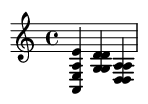What You'll Learn:
Often called the "building blocks of rock," power chords are the driving force behind the sound of rock, punk, and metal. This guide will teach you what power chords are, why they sound so powerful (especially with distortion), how to play them on guitar, and their massive impact on music history. Whether you're a beginner guitarist or a seasoned music enthusiast, this deep dive will enhance your understanding and appreciation of this fundamental musical tool.
Introduction: The Sound of Rebellion
The power chord is one of the most influential harmonic devices in modern music. Stripped down to its bare essentials—a root note and its perfect fifth—it creates a sound that is harmonically ambiguous yet sonically immense. It's not a major chord; it's not a minor chord. It's pure, unadulterated power.
Born from the electrifying marriage of electric guitars and overdriven amplifiers, the power chord became the backbone of rock and roll in the 1950s with pioneers like Link Wray. It has since defined the sound of countless genres, from the raw energy of The Ramones to the crushing weight of Black Sabbath. Its magic lies not just in its simplicity, but in its unique relationship with distortion, an effect that turns conventional chords into a muddy mess but makes power chords roar.
What is a Power Chord? Structure and Theory
Technically, a power chord isn't a "chord" in the traditional sense, which requires three or more distinct notes (like a major or minor triad). A power chord is a dyad—a two-note pairing. It consists of:
- The Root: The fundamental note that gives the chord its name (e.g., the 'G' in a G5 power chord).
- The Perfect Fifth: A note located seven semitones (or half-steps) above the root.
- Optional Octave: The root note repeated an octave higher, which adds thickness without changing the harmony.
The absence of the third interval is the power chord's defining feature. Major and minor chords are defined by their third (a major third or a minor third). By leaving it out, the power chord becomes harmonically neutral, allowing it to function seamlessly in both major and minor key contexts.
Power Chord Formula:
Root (1) + Perfect 5th (5)
Notation: Often written as "C5", "G5", etc., where the "5" signifies the presence of the root and fifth only.
Example: G5 Power Chord = G + D (+ optional G octave)
Essential Power Chord Examples
Here are some fundamental power chord shapes and progressions, shown in both standard notation and guitar tablature (TAB). The TAB shows which string (line) and fret (number) to play.
Example 1: The G5 Power Chord (Two and Three-Note Voicings)
This example shows the two most common ways to play a G5 power chord on guitar. The first is a simple two-note version, and the second adds the octave for a fuller sound.
Example 2: A Classic Rock Progression (A5 - G5 - D5)
This is a classic "movable shape" progression. Notice how the fingering pattern (the shape your hand makes) stays the same; only its position on the fretboard changes.

Why Power Chords Sound So... Powerful
Acoustic Purity
The relationship between the root and the perfect fifth is based on a simple 3:2 frequency ratio. This is the most consonant harmonic interval after the octave. In the natural overtone series of a note, the perfect fifth is the first distinct harmonic to appear after the octave. This means the two notes reinforce each other acoustically, creating a sound that is stable, clear, and resonant.
The Magic of Distortion
This is where power chords truly shine. Distortion (or overdrive) adds extra harmonics (overtones) to the guitar signal. When you play a full major or minor chord with distortion, the complex combination of the original notes and all the new, clashing overtones creates a dissonant, "muddy" sound. Power chords avoid this because:
- Fewer Notes, Less Mud: With only two primary notes, there are far fewer conflicting overtones created.
- Harmonic Reinforcement: The new harmonics generated by the root and the fifth actually align and reinforce each other, making the chord sound thicker, richer, and more powerful. The distortion essentially "fills in" the sonic space without creating dissonance.
How to Play Power Chords on Guitar
The Universal Fingering Shape
The beauty of power chords on the guitar is their movable shape. The most common fingering uses your index and ring fingers (or index and pinky for a bigger stretch or to free up other fingers).
- Root on the 6th (low E) string: Place your index finger on the root note. Place your ring finger on the 5th string, two frets higher. For a three-note chord, add your pinky finger on the 4th string, also two frets higher than the root.
- Root on the 5th (A) string: The same shape moves over one string set. Place your index finger on the root note on the 5th string. Place your ring finger on the 4th string, two frets higher, and your pinky finger on the 3rd string, two frets higher.
Pro Tip: Palm Muting
The secret to a tight, professional power chord sound is palm muting. Gently rest the side of your picking hand on the strings, right where they emerge from the bridge. This dampens the strings, creating a percussive, chunky "chug" sound that is essential for metal and punk rhythm playing. Experiment with moving your hand slightly forward or backward to find the sweet spot between a full ring and a dead mute.
Historical and Genre Impact
A Timeline of Power
- 1950s: Blues guitarist Willie Johnson and early rock pioneers like Link Wray in his iconic 1958 instrumental "Rumble" used distorted two-note chords, laying the groundwork.
- 1960s: The Kinks' "You Really Got Me" brought the sound to the masses. The Who, Cream, and Jimi Hendrix further cemented it as the sound of rock.
- 1970s: Heavy metal was born. Bands like Black Sabbath ("Iron Man") and Deep Purple ("Smoke on the Water") built their entire sonic identity around heavy, menacing power chord riffs.
- 1980s-1990s: Punk (The Ramones, Sex Pistols) weaponized the chord's simplicity and aggression. Grunge (Nirvana, Soundgarden) used it to create a sound that was both heavy and full of angst.
- 2000s-Present: Power chords remain indispensable in nearly every subgenre of rock and metal, from pop-punk to deathcore.
Famous Power Chord Anthems
- "Smoke on the Water" (Deep Purple): Arguably the most famous power chord riff ever written, using parallel fourths (an inversion of fifths).
- "Iron Man" (Black Sabbath): The blueprint for a heavy metal riff, defined by its slow, crushing power chords.
- "Smells Like Teen Spirit" (Nirvana): The quiet-loud dynamic is driven by a simple four-power-chord progression that defined the '90s.
- "Blitzkrieg Bop" (The Ramones): The quintessential punk anthem, built on a fast, simple three-power-chord riff.
- "American Idiot" (Green Day): A modern rock classic demonstrating the enduring energy and appeal of power chords.
Mastering the Technique: Beyond the Basics
String Muting is Non-Negotiable
To play power chords cleanly, especially with distortion, you must mute the strings you are not playing. Use the underside of your fretting index finger to lightly touch and mute the strings below the ones you are fretting. Your fretting hand's other free fingers (and sometimes your picking hand) can help mute the higher strings. Without this, you'll hear a lot of unwanted noise.
Picking Hand Attack
Your picking dynamics dramatically change the character of the chord. An aggressive downstroke delivers a sharp, percussive attack. Using all downstrokes can create a driving, machine-like rhythm, while alternate picking (down-up-down-up) is better for faster passages.
Variations and Extensions
While defined by simplicity, power chords can be embellished. Adding a suspended second (sus2) or suspended fourth (sus4) can add melodic color without introducing a major/minor third. This example shows a C5, a Csus2, and a Csus4.
